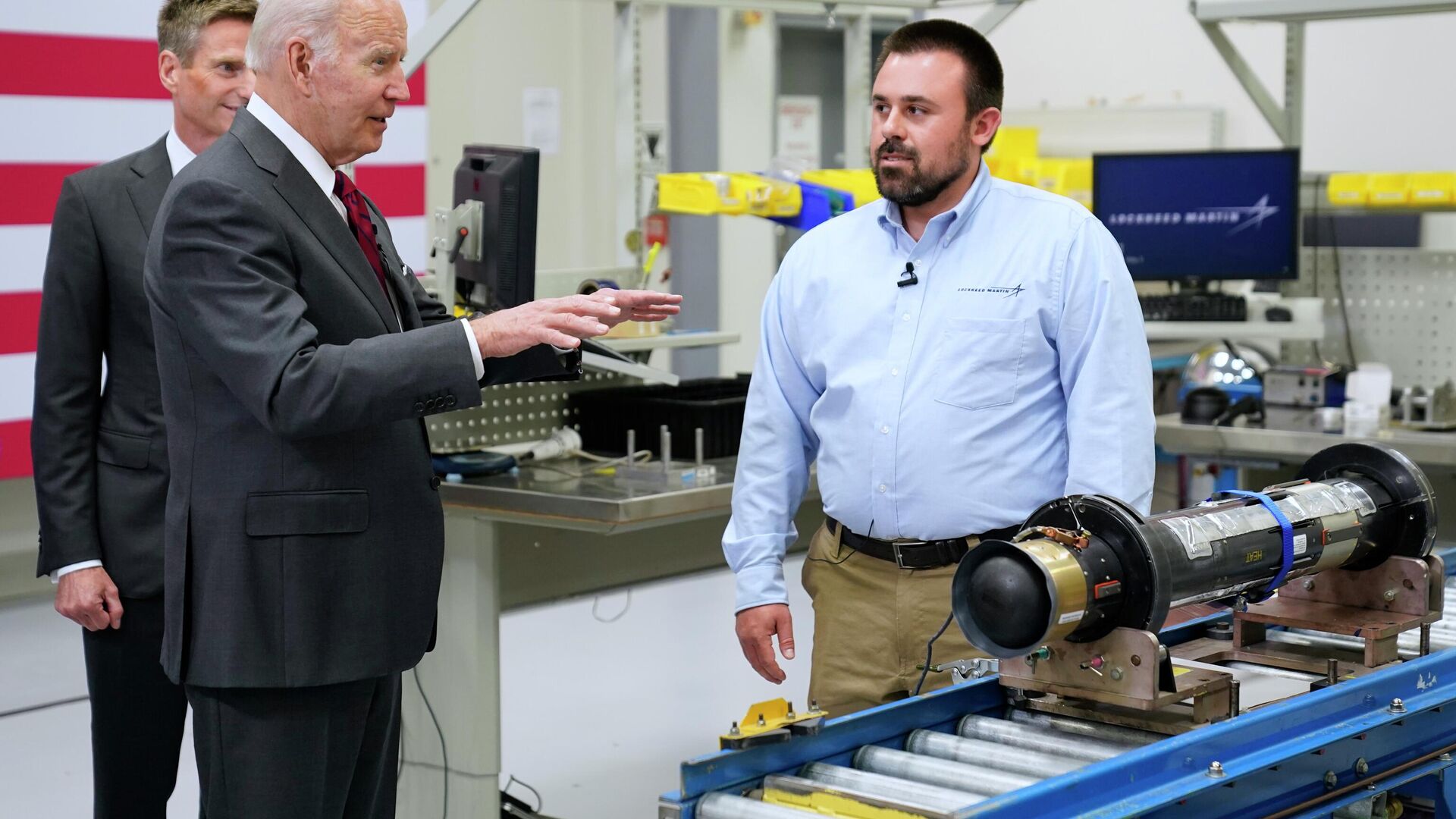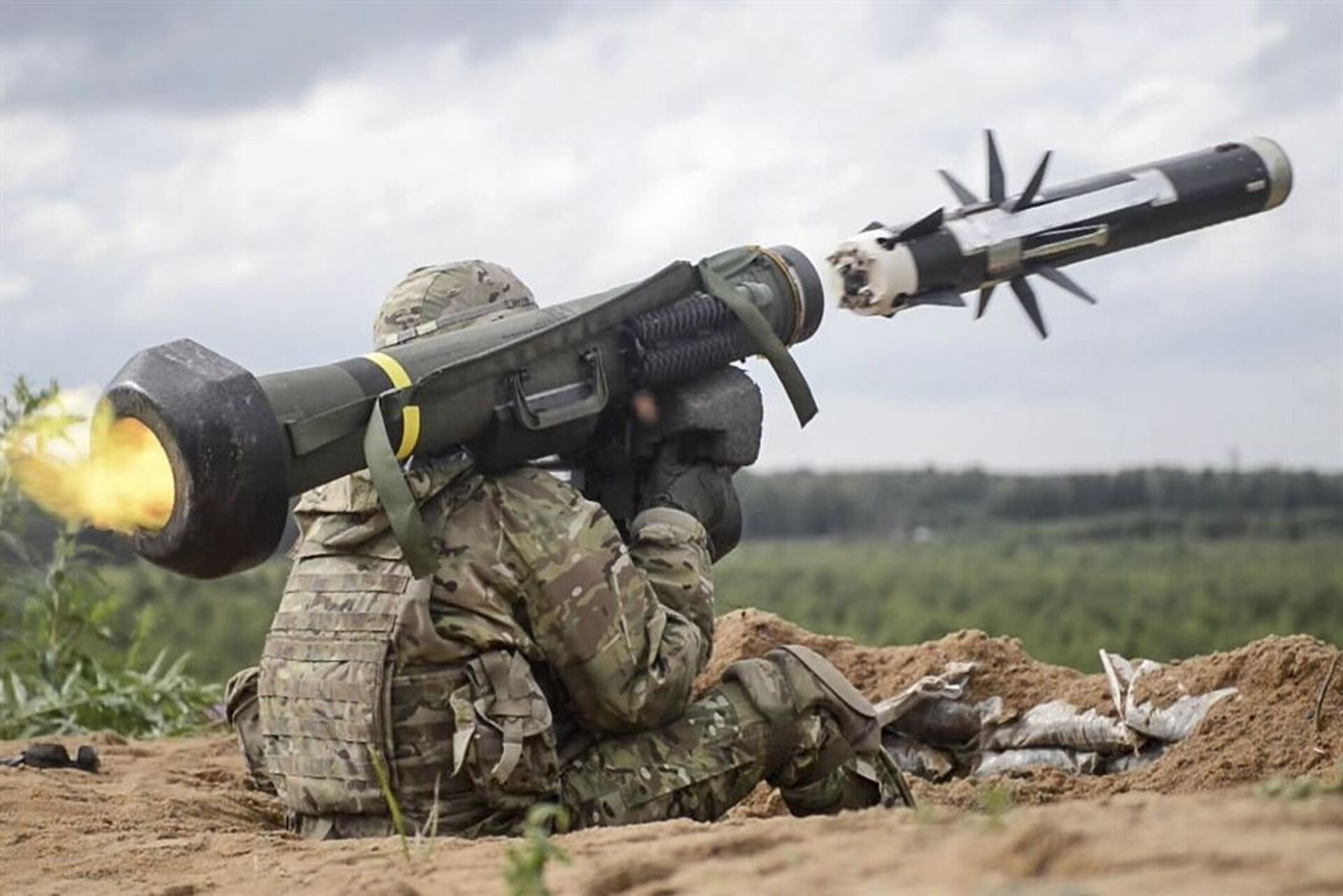https://sputnikglobe.com/20220503/biden-hypes-javelin-as-supplies-run-low-russia-takes-countermeasures-1095245120.html
Biden Hypes Javelin as Supplies Run Low, Russia Takes Countermeasures
Biden Hypes Javelin as Supplies Run Low, Russia Takes Countermeasures
Sputnik International
WASHINGTON (Sputnik) - President Joe Biden during a Javelin plant tour in Alabama championed the weapon as one of the most effective being used by Ukrainian... 03.05.2022, Sputnik International
2022-05-03T23:00+0000
2022-05-03T23:00+0000
2023-04-20T17:06+0000
javelin
joe biden
ukraine
russia
us
military aid
https://cdn1.img.sputnikglobe.com/img/07e6/05/03/1095245382_0:160:3073:1888_1920x0_80_0_0_fc7e90a69c0942197940078e5410818a.jpg
Biden after a tour of a Lockheed Martin facility in Troy, Alabama, that manufactures Javelin anti-tank systems, said the weapon has proven "extremely effective" against a wide range of armored targets in Ukraine, and then warned action is needed to address the Pentagon's dwindling inventory.Biden is escalating his Javelin propaganda campaign just as polls reveal Americans are not satisfied with his handling of the situation in Ukraine.This frustration comes despite the Biden administration committing over $3.4 billion in military assistance to Kiev since Russia’s operation began - including 5,500 javelins. Moreover, Congress is set to approve another $33 billion in aid for Ukraine, including $20 billion of security assistance.Hype vs. RealityThe Javelin FMG-148 is a man-portable anti-armor guided missile system, manufactured by a joint venture between Lockheed Martin and Raytheon, with a range of up to 2.5 miles and infrared technology that allows the user to seek cover immediately after firing.Lockheed Martin has claimed the weapon provides Ukrainian troops with a "game-changing capacity." US officials have argued that the slow Russian advance and flow of Javelins into Ukraine cannot be a coincidence.However, claims about the effectiveness of the Javelin have primarily been supported by anecdotal evidence - including videos and photos circulating online.Western media outlets like Newsweek have cast doubts on figures emanating from Kiev, which claims Ukraine forces have destroyed nearly 1,000 Russian tanks. According to the UK defense ministry and Oryx intelligence between 530 and 570 Russian armored vehicles have been taken out since the operation began.Yet, even if effective in the early fighting near Kiev, doubts loom about its impact in the new phase of the conflict.Constraints & RisksDespite the much-hyped strategy, the US may not be able to keep up the pace of weapons deliveries due to severe supply constraints - including defense contractor component shortages. In March, Kiev said it needs 500 Javelins and 500 Stingers per day, although US officials told CNN the Pentagon believes Ukraine is inflating its requirements.In any case, the US will be hard-pressed to replace its own stockpiles after giving Ukraine one-third of its available Javelin missiles, lawmakers have said. Raytheon has said it will not be able to ramp up production to fulfill Javelin and Stinger requirements until 2023-2024.In response, the Biden administration said it is looking at options to ameliorate shortages including helping contractors find and remove production bottlenecks. Lockheed, for its part, said it will prepay component suppliers and expand production even before the Pentagon places more orders.Sanctions have further complicated the picture because aerospace companies need raw materials like titanium that is produced in Russia, AP reported on Monday.And these figures do not take into account the Russians bombing shipments of foreign weaponry flowing into Ukraine, as they did over the weekend in Odessa.In terms of risks, Moscow has warned that the West’s injection of weapons into Ukraine threatens undermining peace talks, not to mention the likelihood that they could fall into the wrong hands.However, the Biden administration fully realizes this but believes it is worth the risk, CNN said citing officials. The Pentagon is unable to effectively track the weapons once they cross Ukraine borders - a "blind spot" due to lack of American boots on the ground, the report said, and much will likely find its way to the black market.This is concerning given MANPADS that flooded countries like Afghanistan since the 1970s have taken down 60 aircraft, killing 1,000 civilians, and have fallen into the hands of nearly 60 extremist outfits including al-Qaeda* and the Islamic State*, according to a RAND study.Elizabeth Gould and Paul Fitzgerald, the first Western journalists the Afghan communists allowed back into the country in the 1980s, have seen this movie before with Washington’s glorification of the Stinger which the US directly placed into the "wrong hands" during the anti-Soviet jihad.The couple said Biden’s plant visit amounts to an "ad campaign," designed to inflate the Javelin’s value when the reality is the weapon will not help Ukraine win anything - especially if Russia adjusts."The Stingers initially forced Soviet pilots to fly higher and be less accurate in their targeting. The Soviets developed countermeasures after a few months and negated the effects," the authors told Sputnik. "The Stingers didn’t ‘win’ the war. The lousy Soviet economy did."
https://sputnikglobe.com/20220428/biden-us-not-attacking-russia-but-defending-ukraine-will-send-military-aid-until-end-of-operation-1095128545.html
ukraine
Sputnik International
feedback@sputniknews.com
+74956456601
MIA „Rossiya Segodnya“
2022
Sputnik International
feedback@sputniknews.com
+74956456601
MIA „Rossiya Segodnya“
News
en_EN
Sputnik International
feedback@sputniknews.com
+74956456601
MIA „Rossiya Segodnya“
Sputnik International
feedback@sputniknews.com
+74956456601
MIA „Rossiya Segodnya“
javelin, joe biden, ukraine, us, military aid
javelin, joe biden, ukraine, us, military aid
Biden Hypes Javelin as Supplies Run Low, Russia Takes Countermeasures
23:00 GMT 03.05.2022 (Updated: 17:06 GMT 20.04.2023) WASHINGTON (Sputnik) - President Joe Biden during a Javelin plant tour in Alabama championed the weapon as one of the most effective being used by Ukrainian troops, although questions loom over its likely impact in the next phase of the war in light of supply constraints and changing battlefield conditions.
Biden after a tour of a Lockheed Martin facility in Troy, Alabama, that manufactures Javelin anti-tank systems, said the weapon has proven "extremely effective" against a wide range of armored targets in Ukraine, and then warned action is needed to address the Pentagon's dwindling inventory.
"I urge the Congress to pass this funding quickly to help Ukraine continue to succeed… just as they did when they won the battle of Kiev, and to make sure the United States and our allies can replenish our own stocks of weapons to replace what we’ve sent to Ukraine," Biden said during remarks at the facility on Tuesday.
Biden is escalating his Javelin propaganda campaign just as polls reveal Americans are not satisfied with his handling of the situation in Ukraine.
This frustration comes despite the Biden administration committing over $3.4 billion in military assistance to Kiev since Russia’s operation began - including 5,500 javelins. Moreover, Congress is set to approve another $33 billion in aid for Ukraine, including $20 billion of security assistance.
The Javelin FMG-148 is a man-portable anti-armor guided missile system, manufactured by a joint venture between Lockheed Martin and Raytheon, with a range of up to 2.5 miles and infrared technology that allows the user to seek cover immediately after firing.
Lockheed Martin has claimed the weapon provides Ukrainian troops with a "game-changing capacity." US officials have argued that the slow Russian advance and flow of Javelins into Ukraine cannot be a coincidence.
However, claims about the effectiveness of the Javelin have primarily been supported by anecdotal evidence - including videos and photos circulating online.
Western media outlets like Newsweek have cast doubts on figures emanating from Kiev, which claims Ukraine forces have destroyed nearly 1,000 Russian tanks. According to the UK defense ministry and Oryx intelligence between 530 and 570 Russian armored vehicles have been taken out since the operation began.
Yet, even if effective in the early fighting near Kiev, doubts loom about its impact in the new phase of the conflict.
"Given changing terrain and weather, I don’t expect them to be as decisive in the next stage," Brookings scholar Michael O’Hanlon, a member of the Pentagon’s Defense Policy Board, told Sputnik. "Russian forces won’t be limited to roads and rails [and] opportunities for concealment for Ukrainians will be less helpful to the Javelin-based tactics."
Despite the much-hyped strategy, the US may not be able to keep up the pace of weapons deliveries due to severe supply constraints - including defense contractor component shortages. In March, Kiev said it needs 500 Javelins and 500 Stingers per day, although US officials told CNN the Pentagon believes Ukraine is inflating its requirements.
In any case, the US will be hard-pressed to replace its own stockpiles after giving Ukraine one-third of its available Javelin missiles, lawmakers have said. Raytheon has said it will not be able to ramp up production to fulfill Javelin and Stinger requirements until 2023-2024.
In response, the Biden administration said it is looking at options to ameliorate shortages including helping contractors find and remove production bottlenecks. Lockheed, for its part, said it will prepay component suppliers and expand production even before the Pentagon places more orders.
Sanctions have further complicated the picture because aerospace companies need raw materials like titanium that is produced in Russia, AP reported on Monday.
And these figures do not take into account the Russians bombing shipments of foreign weaponry flowing into Ukraine, as they did over the weekend in Odessa.
In terms of risks, Moscow has warned that the West’s injection of weapons into Ukraine threatens undermining peace talks, not to mention the likelihood that they could fall into the wrong hands.
However, the Biden administration fully realizes this but believes it is worth the risk, CNN said citing officials. The Pentagon is unable to effectively track the weapons once they cross Ukraine borders - a "blind spot" due to lack of American boots on the ground, the report said, and much will likely find its way to the black market.
This is concerning given MANPADS that flooded countries like Afghanistan since the 1970s have taken down 60 aircraft, killing 1,000 civilians, and have fallen into the hands of nearly 60 extremist outfits including al-Qaeda* and the Islamic State*, according to a RAND study.
Elizabeth Gould and Paul Fitzgerald, the first Western journalists the Afghan communists allowed back into the country in the 1980s, have seen this movie before with Washington’s glorification of the Stinger which the US directly placed into the "wrong hands" during the anti-Soviet jihad.
The couple said Biden’s plant visit amounts to an "ad campaign," designed to inflate the Javelin’s value when the reality is the weapon will not help Ukraine win anything - especially if Russia adjusts.
"The Stingers initially forced Soviet pilots to fly higher and be less accurate in their targeting. The Soviets developed countermeasures after a few months and negated the effects," the authors told Sputnik. "The Stingers didn’t ‘win’ the war. The lousy Soviet economy did."




